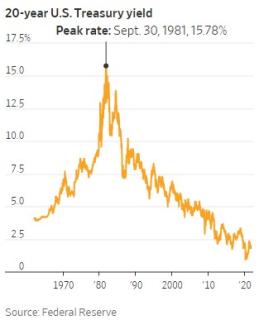
Saying that the Bull Market in Bonds is Over is NOT Market-Timing
By John H. Robinson, November 15, 2021
The accompanying chart plots the 20-year treasury yield over the past 50+ years. For most of the past 40 years, investors in intermediate and long-term bonds and bond mutual funds have profited as falling interest rates pushed the values of existing bonds higher. With yields now hovering around 2%, you don't have to be Nostradamus to foresee that the bond market performance of the last few decades cannot continue.
While interest rates may stay low for a while longer, at some point they will likely have to rise. When rates rise, the values of existing bonds fall, and when that happens investors in bond mutual funds (including target-date retirement funds), may find the volatility to be at odds with their perception of the funds as "conservative."
For more on this topic, I encourage you to read Wall Street Journal Intelligent Investor columnist Jason Zweig's recent contribution, When Interest Rates Turn the Corner. Here are excerpted quotes from two legendary bond fund managers -
"Between September 1977 and September 1981, the yield on outstanding long-term corporate bonds had shot from 7.92% to 15.49%. Younger people might say today, ‘That’s impossible, bond markets don’t move like that, don’t collapse like that.’ Yes, they can!” - Dan Fuss
"Things can’t go on forever at these rates. Interest rates can’t stay this low [net of inflation] because savers, whether it’s Mom and Pop in Des Moines or big pension funds, can’t earn anything on their investment. For the economy to survive, at some point interest rates have to regain some semblance of an attraction to savers. Otherwise, the savings function will be destroyed.” - Bill Gross
I continue to recommend that FPH clients avoid bonds and bond funds and hold cash until we can get 1% or more on risk-free short-term CDs and/or treasuries. It is worth mentioning that interest rates on fixed annuity contracts have ticked up a little bit recently. For the first time in about 18 months, we are seeing 2-year fixed annuities paying over 2% and 5-year contracts paying over 3%.
Related Reading
When Interest Rates Turn the Corner (Wall Street Journal, 10/1/2021)
Why do Bond Prices Go Down When Interest Rates Rise (The Balance, 10/202/2021)
John H. Robinson is the owner/founder of Financial Planning Hawaii and a co-founder of software-maker Nest Egg Guru.
DISCLOSURES
Securities offered through J.W. Cole Financial, Inc. (JWC) member FINRA/SIPC. Advisory services offered through Financial Planning Hawaii and J.W. Cole Advisors, Inc. (JWCA). Financial Planning Hawaii and JWC/JWCA are unaffiliated entities.
Fee-only financial planning services are provided through Financial Planning Hawaii, Inc, a separate Registered Investment Advisory firm. Financial Planning Hawaii does not take custody of client assets nor do its advisers take discretionary authority over client accounts.
The information contained herein is general in nature. Neither Financial Planning Hawaii nor J.W. Cole provides client-specific tax or legal advice. All readers should consult with their tax and/or legal advisors for such guidance in advance of making investment or financial planning decisions with tax or legal implications.

